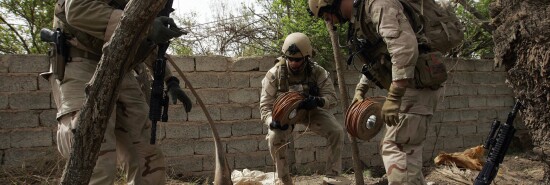
Bomb busters
Trent Reedy
As a U.S. Army combat engineer who worked with explosives, I always admired people in explosives ordnance disposal, or EOD. These are the military’s technically proficient warriors who disarm or safely destroy all types of explosive devices. Because most methods for disposing of unexploded ordnance, UXO, involve controlled detonations, EOD personnel are pros at rigging complex explosives systems. Amazing. If the good people responsible for editing each splendid issue of the Washington Examiner wouldn’t object, I’d happily share explosives stories for the rest of my life. So obviously, I was excited to talk to former Air Force EOD Tech. Sgt. Seth Briggs.
Briggs joined the Air Force in 2001. After 9/11, he knew he’d signed up to go to war. But before he was unleashed to blow things up in the desert, he had to pass EOD training. He and 24 other rookie airmen first endured a prelim course to qualify for EOD school. Only half passed and went on to the multibranch-staffed Navy School EOD at Eglin Air Force Base in Florida.
At the school, everyone but Briggs and his fellow airmen had rank, and many of the students were experienced service members re-classing from different specialties. But being a low-ranking outsider was the least of his problems. The first three days of the school consisted of eight hours of intense technical instruction followed by exactly three hours of monitored silent book study. At the end of study time, all materials were collected by the instructor. The next day, students were tested on the previous day’s material. Fail once? Retest. Fail the retest? Go in front of a board of senior enlisted explosives experts to prove worthiness to continue the school. Half the class washed out in the first three days.
The school covered everything — identification of rockets, missiles, and bombs, and demolitions including C4 explosives and TNT, as well as shape and cratering charges and the long sectional pipe bomb known as the Bangalore torpedo.
Students had to endure training for biological and chemical weapons. They did this under the hot Florida sun wearing full mission-oriented protective posture, or MOPP, gear — thick charcoal-lined pants and coat, rubber gloves, rubber overboots, and a gas mask with hood. Anyone who removed his mask failed the course.
“It only takes three gulps to swallow the puke in your mask,” Briggs told me.
After bio/chem, they learned about ground weapons like rocket-propelled grenades. They practiced “render safe procedures” so they could, for example, make UXO discovered in an urban environment secure for transport to a safe demolition site.
They learned to defuse or destroy air weapons such as guided missiles and bombs. Finally, the students were trained on what would become their most important mission for the next 20 years: improvised explosive devices — IEDs. In this phase, they worked with robots and a lot of really cool improvised systems of their own.
“That was really difficult,” Briggs said. “There are many steps not in the manual.”
Seth Briggs worked hard and had to retake a few tests, but finally, he was the only one of the 12 airmen who passed the school. Upon reaching his unit, he was told, “You don’t know s***.”
Seth agrees: “There was so much more to learn with my unit.”
He did learn. After 9/11, EOD was extraordinarily busy in Iraq and Afghanistan. Briggs served through eight deployments, including intense missions with elite units in both theaters, clearing routes, destroying UXO, and fighting the battle against IEDs.
The EOD school’s motto was “Initial success or total failure.” With explosives, it’s critical to do the job correctly. Again and again, over a fine career, Tech. Sgt. Seth Briggs got it right.
Trent Reedy, author of several books, including Enduring Freedom, served as a combat engineer in the Iowa National Guard from 1999 to 2005, including a tour of duty in Afghanistan.
*Some names and call signs in this story may have been changed due to operational security or privacy concerns.
